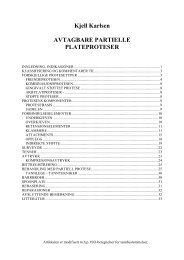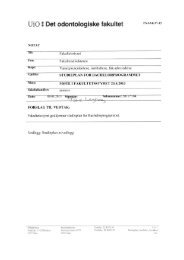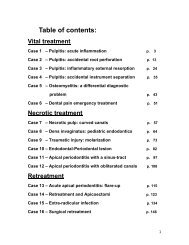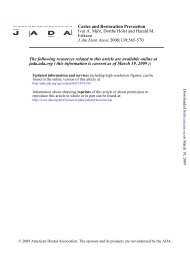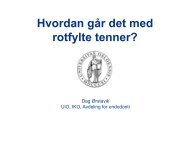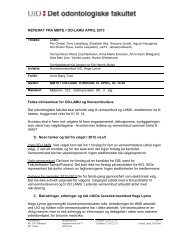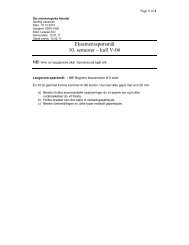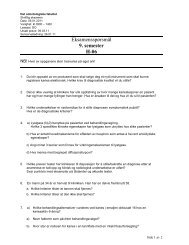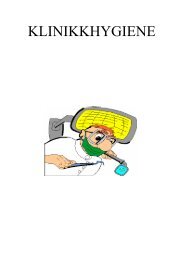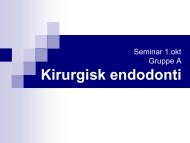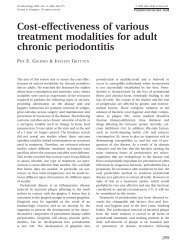Behandlingsprinsipper: tenner med nekrotisk/infisert pulpa ...
Behandlingsprinsipper: tenner med nekrotisk/infisert pulpa ...
Behandlingsprinsipper: tenner med nekrotisk/infisert pulpa ...
You also want an ePaper? Increase the reach of your titles
YUMPU automatically turns print PDFs into web optimized ePapers that Google loves.
Infected pulp;apical periodontitisInstrumentation& irrigationDressingVitalFilled &healingCompletehealing?Root canal infectionTime
Infected pulp;apical periodontitisInstrumentation& irrigationDressingVitalFilled &healingCompletehealingInstrumentering: Apex – 1,5mm, bredde ISO040+Irrigering: Dakin’s væske, EDTA 15-17%Innlegg: Kalsiumhydroxid mettet pastaFylling: AH+ og guttaperka; tett toppfylling
T=0 T=+6m
Standard behandling• Isolasjon og aseptikk: se websidensklinikkrutiner og om kofferdam• Mekanisk og kjemisk eliminasjon av mikrober:NaOCl, EDTA, [CHX,] Ca(OH) 2. Sammewebside.• Permanent rotfylling <strong>med</strong> koronal forsegling:Gutta-perka og sealer; standardisert teknikk,lateral kondensering, tett underfylling, tettkoronal restaurering. Cave compositem!
Prøvning avinfeksjonskontrollPrøveAPIPDVed kanalåpningEtter første gangs instrumenteringStarten av annen seanse
Desinfeksjon av rotkanalen:bakteriologiske studierLaw A, Messer H. Endod. 2004 Oct;30(10):689-94100755025Før behandlingEtter irrigasjonEtter innlegg25 % forblir <strong>infisert</strong>!!0S 91 Sh 00 YBD 94 Ø 91 P 02 AvgInstitusjoner – optimal behandling; nye metoder oppdager flere mikrober
Primær rotkanalinfeksjon“The involved microbiota isdominated by anaerobic bacteria,particularly Gram-negativespecies such as Porphyromonas,Prevotella, Fusobacterium,Filifactor, Campylobacter andTreponema. Gram-positiveanaerobes, Peptostreptococcus,Eubacterium, andPseudoramibacter, as well asfacultative or microaerophilicstreptococci can also be commonlyfound in primary intraradicularinfections.” (EssentialEndodontology 2008)
Sekundær rotkanalinfeksjon• “Species commonlyassociated with secondaryinfections includefacultative organisms,Pseudomonas aeruginosa,Staphylococcus species,E. coli, other enteric rods,Candida species, and E.faecalis, all of them notusually found in primaryinfections.” (EssentialEndodontology 2008)+ 1 year
Persisterenderotkanalinfeksjon“The microbiota of persistentinfections usually consists offewer species than primaryinfections. Gram-positivefacultative bacteria,particularly E. faecalis, arepredominant. Fungi can also befound, in frequenciessignificantly higher whencompared with primaryinfections.” (EssentialEndodontology 2008)+ 1 year
Ekstraradikulærinfeksjon“The most commonextraradicularinfection, independentof the intraradicularinfection, is apicalactinomycosis,caused byActinomycesspecies or P.propionicum “(FromSiqueira tbp)
Hvor er mikrobene?Hva kan vigjøre <strong>med</strong> dem?InstrumenteringIrrigasjonInnleggFyllingP
Kofferdam og aseptikk• http://www.odont.uio.no/om/iko/fagavdelinger/endodonti/Klinikkrutiner/index.html• Kofferdam etter kanallokaliseringved <strong>infisert</strong>e kasus!• Tett gingivalt – oppbygging ellerTempBond eller lignende, tanntrådknyttet• Nytt instrumentoppsett, sterileinstrumenter
Medikamentenesfunksjoner2435(1) Fukting av kanalveggene ogutspyling av debris(2) Drepe mikrober.(3) Løse opp vevsrester.(4) Fjerne smearlaget og løse opp ytrdentin(5) Rense områder utenfor mekaniskrekkeviddde1(Innlegg) Ca(OH)2: desinfiserer ogfyllerfra Sundqvist & Figdor, in ’Essential Endodontology, 1. utgave 1998
Bakterievekst etter instrumentering:in vitro; E. faecalisInstrument% Red.NiTi #30 98.17NiTi #35 99.50NiTi #40 99.57*GT hand 0.12t 94.17Profile 0.06t/#5 97.26Siqueira et al. 1999Understøttet i flere kliniske studier; Shuping, Sigurdsson, Trope, Orstavik et al 1999-2004
Endodontics• What is endodontic success?• What is endodontic failure?– Many things, but one common factor: a lesion• What is a lesion?– A granuloma or a cyst– Caused by (exclusively) microbes in the rootcanal system• How do we improve?– By recognizing etiology
Endodontisk prognose• Hva er endodontisk suksess?• Hva er endodontisk mislykket behandling?– Ymse former av infeksjon <strong>med</strong> en røntgenologisk lesjon• Hva er en lesjon?– Et granulom eller en cyste– Den ”eneste” årsak er infeksjon i rotkanalsystemet• Hvordan kan vi forbedre oss?– Ved å erkjenne etiologien og rette allbehandling mot den
En nødvendig distinksjon:• Den vitale <strong>pulpa</strong> – et spørsmål om aseptikk– Enkelt: Vi desinfiserer for å opprettholdeaseptikk; vi bruker prosedyrer utviklet for<strong>infisert</strong>e <strong>pulpa</strong>e for å være på den sikre siden• Den <strong>nekrotisk</strong>e, <strong>infisert</strong>e <strong>pulpa</strong> –utfordringen– Effektiv desinfeksjon er nødvendig for etvellykket resultat
Trenger vi å forbedre oss?• Hvordan går det i praksis?–Institusjoner – <strong>infisert</strong>e<strong>tenner</strong>: 70-85% suksesssuksess–Epidemiiologiske studier –alle diagnoser: 60-70%suksess
Waltimo et al., 20051 2 3 4 5Konklusjonen er klar:bakterier i kanalen vedfylling er årsaken tildårlig prognose
Utvalgte etterundersøkelser på utfallet avrotbhandling av <strong>tenner</strong> <strong>med</strong> kronisk apikalperiodontitt (Essential Endodontology 2008)Forfatter% suksessSjögren, et al. 1997 83Trope et al. 1999 74Weiger et al. 2000 71Abitbol 2001 76Peters & Wesselink 2002 71Institusjoner – optimal behandling
Klorhexidin dreper E. faecalis inntil 0,45 mminn i dentintubuli1.0Bacterial growth (opticaldensity)0.80.60.40.20.00.1 0.2 0.35 0.45Depth into dentin, mmSaline 7dNaOCL 7dCHX 7dKomorowski et al. 2000, Substantivity of Chlorhexidine-Treated Bovine Root Dentin
Inhibition ofantibacterial effect• Pulpal tissue• Smear• Hydroxyapatite• Collagen• Microbes: alive or dead• All above inhibitdisinfection: emphasisalso on mechanicalcleansing
Effect of physiological state – Ca(OH) 2Old and starving bacteria are moreresistant to <strong>med</strong>icaments100cfu%1010.13h12h48h0.010.0010'' 3'' 30'' 60'' 3' 6' 10'From Portenier et al., 2005
Effect of physiological state – Ca(OH) 2E. faecalis bound to collagen becomesmore resistant to the antimicrobial effect ofcalcium hydroxide. This finding maycontribute to our understanding of why E.faecalis cannot be eliminated easily fromthe dentinal tubules using <strong>med</strong>icamentssuch as calcium hydroxide.Kayaoglu & Orstavik, in prep
Prognose & epidemiologi• Suksess og feilslag• Bruk i andre restaureringer• Forhold til alternative behandlinger(= ekstraksjon) og relative prognoser• Forholdet til periodontale problemer• Tverrsnittsresultater i befolkningen
99-0199-0801-08
Community Dent Oral Epidemiol. 2003 Feb;31(1):59-67Risk indicators for apical periodontitisLise-Lotte Kirkevang and Ann WenzelVariables Category Adjusted OR 95% CI (P)Age20-29 (n = 111) 1.00 -30-39 (n = 153) 1.82 0.80-4.12 (0.15)40-49 (n = 169) 1.24 0.54-2.86 (0.61)50-59 (n = 144) 2.38 0.97-5.85 (0.59)60+ (n = 36) 1.80 0.40-8.39 (0.43)SmokingNo (n = 325) 1.00 -Yes (n = 250) 1.64 1.00-2.84 (0.05)Number ofservices fromthe dentist0 (n = 82) 3.98 1.87-8.46 (0.00)1-5 (n = 309) 1.00 -6-9 (n = 127) 0.89 0.47-1.67 (0.70)10-19 (n = 56) 0.99 0.39-2.47 (0.90)20+ (n = 12) 12.63 0.79-200.07 (0.07)Adjusted odds ratio (OR) with 95% confidence intervals (CI) and P-values.
Variables Category Adjusted OR 95% CI (P)Number of teethNumber of secondarycariesNumber of inadequatecoronal fillingsNumber of root fillings1-18 (n = 22) 1.00 -19-27 (n = 280) 0.66 0.18-2.49 (0.54)28 (n = 311) 0.34 0.09-1.34 (0.12)0 (n = 403) 1.00 -1 (n = 141) 0.95 0.51-1.79 (0.88)2 (n = 69) 2.63 1.01-6.87 (0.05)0-2 (n = 474) 1.00 -3 (n = 134) 2.44 1.17-5.07 (0.02)0 (n = 295) 1.00 -1 (n = 140) 11.18 5.99-20.85 (0.00)2 (n = 178) 80.07 38.19-167.87 (0.00)Adjusted odds ratio (OR) with 95% confidence intervals (CI) and P-values.
30Remaining teeth, avg per personRoot-filled teeth, % of teethApical periodontitis, % of teethEriksen 1998252015105020 40 60AGE, years



